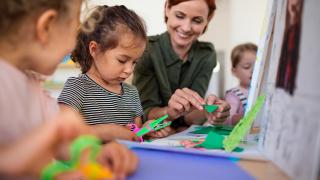Relating Preschool Class Size to Classroom Quality and Student Achievement

July 5, 2019
By Jessica Francis & W. Steven Barnett
This paper examines the effects of preschool class size on classroom quality and student achievement by drawing upon data from 21 teachers and 354 children that were collected during the 2008–2009 school year. Regular class sizes contained 20 students and reduced class sizes contained 15 students. Either the AM or PM session was randomly assigned to be 15 students for each teacher, so that each teacher taught both a regular and reduced class size.
Children who attended reduced size classrooms were found to partake in more one-to-one interactions with teachers than children in regular size classrooms, but there were no differences between groups in the quality of classroom interactions as measured by the Classroom Assessment Scoring System (CLASS). Children in smaller classrooms also were found to gain more in literacy skills by the end of preschool. In contrast, there were no significant differences between groups in vocabulary or math gains.
These results indicate that an assigned difference of five children in a preschool classroom can benefit children’s cognitive development after just one school year. However, these benefits are not explained by differences in a commonly used measure of classroom quality, which were minimal. Future endeavors to reduce class size in preschool might be enhanced if coupled with professional development strategies that aim to maximize teachers’ effectiveness with smaller classes.
The Authors
W. Steven (Steve) Barnett is a Board of Governors Professor and the founder and Senior Co-Director of the National Institute for Early Education Research (NIEER) at Rutgers University. Dr. Barnett’s work primarily focuses on public policies regarding early childhood education, child care, and child development.
